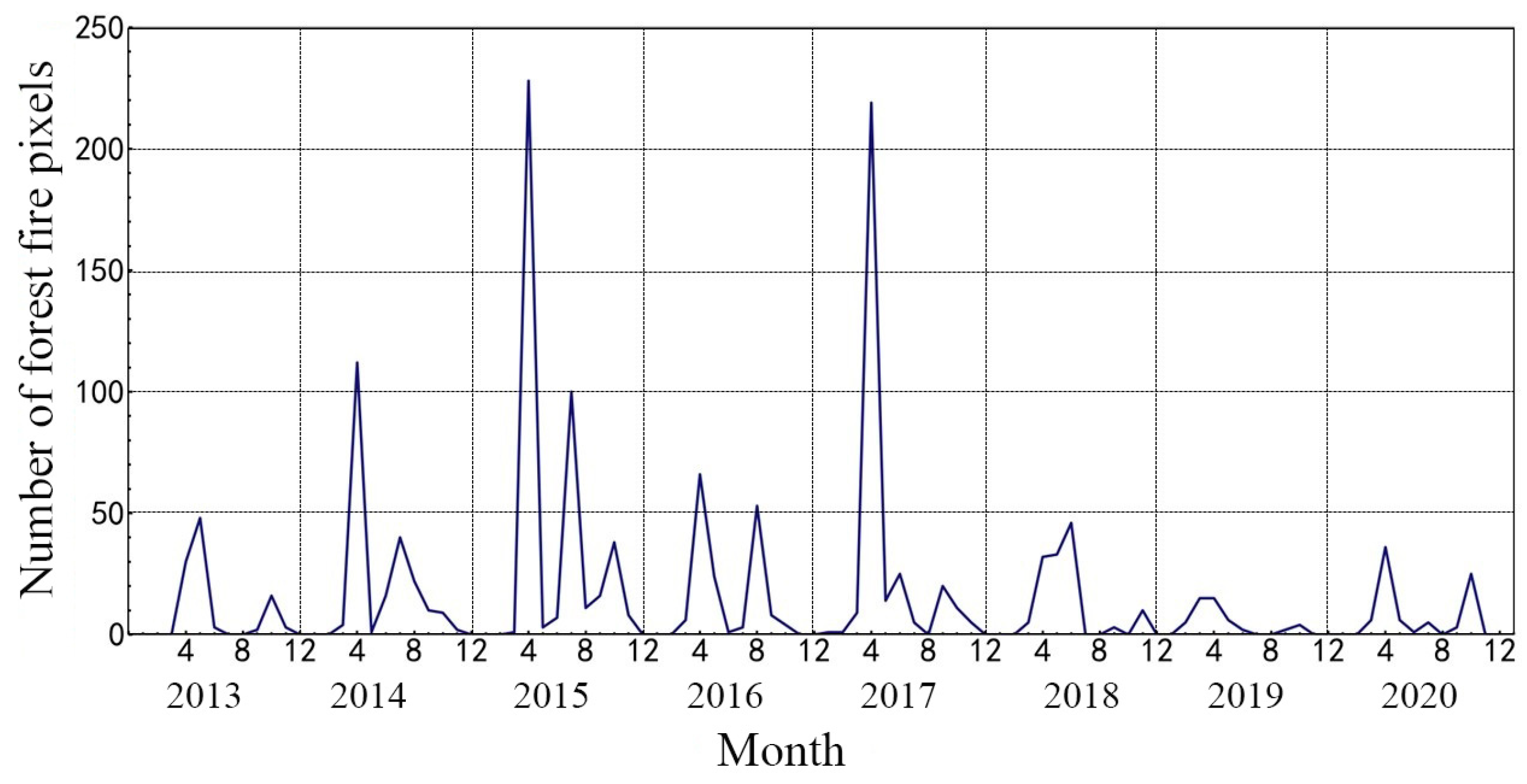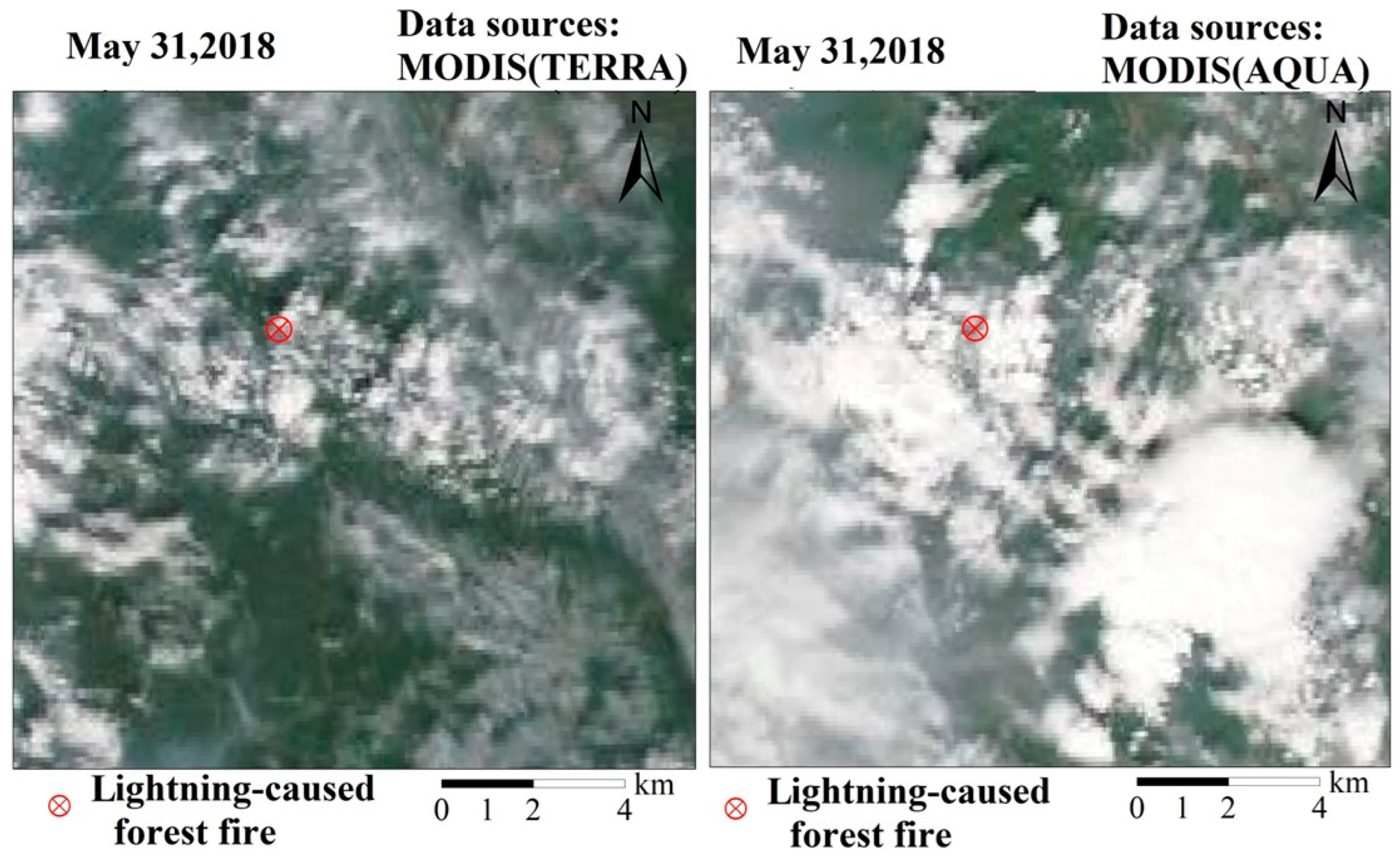Forest Fire Patterns and Lightning-Caused Forest Fire Detection in Heilongjiang Province of China Using Satellite Data
Abstract
:1. Introduction
2. Data and Processing
2.1. Study Region
2.2. VIIRS Data and Forest Fire Records
2.3. Land Cover Dataset
2.4. Data Processing
3. Results and Discussion
3.1. Spatial and Temporal Distribution of Forest Fires Detected by VIIRS
3.2. Capacity of Satellite for Forest Fire Detection
3.3. Capacity of Satellite for Lightning-Caused Forest Fire Detection
3.4. Lightning-Caused Forest Fire Cases
3.5. Discussion
4. Conclusions
- The maximum and minimum numbers of forest fire pixels were observed in 2015 and 2019, respectively. The number of forest fire pixels detected by satellite remote sensing is consistent with the trend of changes in the number of historically recorded forest fires. The area over a forest fire is not necessarily correlated with the number of satellite-detected or historically recorded forest fires, due to the long duration of individual fires over a large area. The number of forest fire pixels varied in an M-shaped pattern each year, with a peak in April.
- Analysis of the reasons of historical forest fires reveals that 77.6% of forest fires are caused by lightning strikes. Matching VIIRS forest fire location data with historical ground forest fire data shows that less than 30% of forest fires were detected by satellite, and lightning strikes account for less than 15% of forest fires. A comparison between the timing of satellite observations of forest fires with ground observations shows that 82.4% of forest fires were initially detected by satellite remote sensing. The proportion of fires detected by VIIRS decreased over time, while the proportion of fires caused by lightning increased in the study period, with a highly significant negative correlation coefficient of 0.89 between the two.
- Based on the analysis of lightning-caused forest fire data in the study area from 2013 to 2020, it was found that these fires are mainly concentrated in the Daxing’an Mountains and occur predominantly during May, June, and July. The difficulty in monitoring lightning-caused forest fires is primarily due to cloud cover and limited satellite transit. Specifically, 141 and 101 lightning-caused forest fires were not detected by satellite due to these factors, respectively. The study reveals that certain conditions must be met for a fire to start when lightning strikes combustible material on the ground. In clear weather conditions, the resulting fire can usually be observed through satellite transit. However, if the lightning strike is followed by ignition immediately, thick clouds often obscure the satellite’s view of the lightning-caused forest fires.
Author Contributions
Funding
Data Availability Statement
Acknowledgments
Conflicts of Interest
References
- Agbeshie, A.A.; Abugre, S.; Atta-Darkwa, T.; Awuah, R. A Review of the Effects of Forest Fire on Soil Properties. J. For. Res. 2022, 33, 1419–1441. [Google Scholar] [CrossRef]
- Xu, R.; Lin, H.; Lu, K.; Cao, L.; Liu, Y. A Forest Fire Detection System Based on Ensemble Learning. Forests 2021, 12, 217. [Google Scholar] [CrossRef]
- Ma, W.; Feng, Z.; Cheng, Z.; Chen, S.; Wang, F. Identifying Forest Fire Driving Factors and Related Impacts in China Using Random Forest Algorithm. Forests 2020, 11, 507. [Google Scholar] [CrossRef]
- Dimopoulou, M.; Giannikos, I. Towards an Integrated Framework for Forest Fire Control. Eur. J. Oper. Res. 2004, 152, 476–486. [Google Scholar] [CrossRef]
- Flannigan, M.D.; Krawchuk, M.A.; de Groot, W.J.; Wotton, B.M.; Gowman, L.M. Implications of Changing Climate for Global Wildland Fire. Int. J. Wildland Fire 2009, 18, 483. [Google Scholar] [CrossRef]
- Tian, Y.; Wu, Z.; Li, M.; Wang, B.; Zhang, X. Forest Fire Spread Monitoring and Vegetation Dynamics Detection Based on Multi-Source Remote Sensing Images. Remote Sens. 2022, 14, 4431. [Google Scholar] [CrossRef]
- Tian, X.; Zhao, F.; Shu, L.; Wang, M. Distribution Characteristics and the Influence Factors of Forest Fires in China. For. Ecol. Manag. 2013, 310, 460–467. [Google Scholar] [CrossRef]
- Yin, S.; Song, G.; Shan, Y.; Gao, B.; Fei, S. Spatial Distribution Analysis of Main Forest Fire Sources in Jilin Province. J. Northeast For. Univ. 2019, 47, 79–84+88. [Google Scholar] [CrossRef]
- Yang, S.; Cao, M.; Zhu, X.; Cheng, Y.; Zheng, C.; Bai, Y. A study on the occurrence pattern of forest fires in the northern Daxing’an Mountains primary forest area of Inner Mongolia, 2001–2019. J. Catast. 2022, 37, 122–128. [Google Scholar]
- Zumbrunnen, T.; Menéndez, P.; Bugmann, H.; Conedera, M.; Gimmi, U.; Bürgi, M. Human Impacts on Fire Occurrence: A Case Study of Hundred Years of Forest Fires in a Dry Alpine Valley in Switzerland. Reg. Environ. Chang. 2012, 12, 935–949. [Google Scholar] [CrossRef]
- Fu, Y.; Li, R.; Wang, X.; Bergeron, Y.; Valeria, O.; Chavardès, R.D.; Wang, Y.; Hu, J. Fire Detection and Fire Radiative Power in Forests and Low-Biomass Lands in Northeast Asia: MODIS versus VIIRS Fire Products. Remote Sens. 2020, 12, 2870. [Google Scholar] [CrossRef]
- Briones-Herrera, C.I.; Vega-Nieva, D.J.; Monjarás-Vega, N.A.; Briseño-Reyes, J.; López-Serrano, P.M.; Corral-Rivas, J.J.; Alvarado-Celestino, E.; Arellano-Pérez, S.; Álvarez-González, J.G.; Ruiz-González, A.D.; et al. Near Real-Time Automated Early Mapping of the Perimeter of Large Forest Fires from the Aggregation of VIIRS and MODIS Active Fires in Mexico. Remote Sens. 2020, 12, 2061. [Google Scholar] [CrossRef]
- Cardil, A.; Monedero, S.; Ramírez, J.; Silva, C.A. Assessing and Reinitializing Wildland Fire Simulations through Satellite Active Fire Data. J. Environ. Manag. 2019, 231, 996–1003. [Google Scholar] [CrossRef]
- He, X.; Li, R.; Zhang, F.; Wang, X.; Chen, L.; Tao, M.; Mei, X.; Song, X. Analysis of the Spatial and Temporal Patterns of Biomass Burning in Hubei Province Based on VIIRS and the Influencing Factors. Resour. Environ. Yangtze Basin 2022, 31, 1627–1640. [Google Scholar]
- Cao, H.; Meng, X.; Kong, M.; Yu, H.; Chen, Y.; Wang, K.; Liu, C.; Liu, X. Spatiotemporal Variation of Straw Burning in Shandong Province Based on VIIRS Data. Environ. Sci. Technol. 2022, 45, 152–161. [Google Scholar] [CrossRef]
- Wang, L. Study on Distribution Characteristics and Risk Grade Division of Forest Fire in Nanchong City; China West Normal University: Nanchong, China, 2020. [Google Scholar]
- Styger, J.; Marsden-Smedley, J.; Kirkpatrick, J. Changes in Lightning Fire Incidence in the Tasmanian Wilderness World Heritage Area, 1980–2016. Fire 2018, 1, 38. [Google Scholar] [CrossRef]
- Shu, Y.; Shi, C.; Yi, B.; Zhao, P.; Guan, L.; Zhou, M. Influence of Climatic Factors on Lightning Fires in the Primeval Forest Region of the Northern Daxing’an Mountains, China. Sustainability 2022, 14, 5462. [Google Scholar] [CrossRef]
- Cattau, M.E.; Wessman, C.; Mahood, A.; Balch, J.K. Anthropogenic and Lightning-started Fires Are Becoming Larger and More Frequent over a Longer Season Length in the U.S.A. Glob. Ecol. Biogeogr. 2020, 29, 668–681. [Google Scholar] [CrossRef]
- Wu, Z.; Li, M.; Wang, B.; Quan, Y.; Liu, J. Using Artificial Intelligence to Estimate the Probability of Forest Fires in Heilongjiang, Northeast China. Remote Sens. 2021, 13, 1813. [Google Scholar] [CrossRef]
- Wang, X.; Wang, C.; Zhao, G.; Ding, H.; Yu, M. Research Progress of Forest Fires Spread Trend Forecasting in Heilongjiang Province. Atmosphere 2022, 13, 2110. [Google Scholar] [CrossRef]
- Guo, F.T.; Hu, H.Q.; Sun, L.; Ma, Z.H. Spatial Patterns of Lightning-Ignited Forest Fires in Daxing’an Mountains, Heilongjiang Province, China, 1973–1997. Adv. Mater. Res. 2011, 183–185, 2268–2274. [Google Scholar] [CrossRef]
- Justice, C.O.; Román, M.O.; Csiszar, I.; Vermote, E.F.; Wolfe, R.E.; Hook, S.J.; Friedl, M.; Wang, Z.; Schaaf, C.B.; Miura, T.; et al. Land and Cryosphere Products from Suomi NPP VIIRS: Overview and Status. J. Geophys. Res. Atmos. 2013, 118, 9753–9765. [Google Scholar] [CrossRef]
- Cao, C.; Xiong, X.; Blonski, S.; Liu, Q.; Guenther, B.; Weng, F. Suomi NPP VIIRS On-Orbit Performance, Data Quality, and New Applications. In Proceedings of the Earth Observing Missions and Sensors: Development, Implementation, and Characterization II, Kyoto, Japan, 9 November 2012; Volume 8528. [Google Scholar] [CrossRef]
- Yang, J.; Huang, X. The 30 m Annual Land Cover Dataset and Its Dynamics in China from 1990 to 2019. Earth Syst. Sci. Data 2021, 13, 3907–3925. [Google Scholar] [CrossRef]
- Wang, L.; Jin, G.; Xiong, X.; Wu, K.; Huang, Q. Mapping Urban Land Dynamics by Automatic Generation of Ground Samples from Globeland30 and Random Forest Classification on the Google Earth Engine. J. Appl. Rem. Sens. 2022, 16, 034526. [Google Scholar] [CrossRef]
- Spruce, J.P.; Ryan, R.E.; Mckellip, R. Potential of VIIRS Time Series Data for Aiding the USDA Forest Service Early Warning System for Forest Health Threats: A Gypsy Moth Defoliation Case Study. 2008. Available online: https://ntrs.nasa.gov/citations/20080008850 (accessed on 5 January 2023).
- Wierzchowski, J.; Heathcott, M.; Flannigan, M.D. Lightning and Lightning Fire, Central Cordillera, Canada. Int. J. Wildland Fire 2002, 11, 41. [Google Scholar] [CrossRef]
- Rorig, M.L.; Ferguson, S.A. Characteristics of lightning and wildland fire ignition in the Pacific Northwest. J. Appl. Meteorol. 1999, 38, 1565–1575. [Google Scholar] [CrossRef]
- Duncan, B.W.; Adrian, F.W.; Stolen, E.D. Isolating the lightning ignition regime from a contemporary background fire regime in east-central Florida, USA. Can. J. For. Res. 2010, 40, 286–297. [Google Scholar] [CrossRef]
- Cha, D.; Wang, X.; Kim, J.W. Assessing Lightning and Wildfire Hazard by Land Properties and Cloud to Ground Lightning Data with Association Rule Mining in Alberta, Canada. Sensors 2017, 17, 2413. [Google Scholar] [CrossRef]
- Zhang, J.H.; Yao, F.M. Advance in Monitoring Forest Fire in China Based on Multi-Satellite Data. Adv. Mater. Res. 2012, 518–523, 5668–5672. [Google Scholar] [CrossRef]
- Zhang, J.H.; Yao, F.M.; Liu, C. Detection, Emission Estimation and Risk Prediction of Forest Fires in China Using Satellite Sensors and Simulation Models in the Past Three Decades—An Overview. Int. J. Environ. Res. Public Health 2011, 8, 3156–3178. [Google Scholar] [CrossRef]
- Fza, B.; Yl, B.; Ls, A. Change in the fire season pattern from bimodal to unimodal under climate change: The case of Daxing’anling in Northeast China. Agric. For. Meteorol. 2020, 291, 108075. [Google Scholar] [CrossRef]










| Year | Pixels | Numbers | Burned Areas (ha) |
|---|---|---|---|
| 2013 | 102 (7.0%) | 14 (3.6%) | 11.01 (0.4%) |
| 2014 | 216 (14.8%) | 33 (8.6%) | 141.82 (4.7%) |
| 2015 | 412 (28.3%) | 94 (24.5%) | 158.01 (5.2%) |
| 2016 | 165 (11.3%) | 28 (7.3%) | 42.54 (1.4%) |
| 2017 | 310 (21.3%) | 97 (25.3%) | 238.66 (7.9%) |
| 2018 | 129 (8.9%) | 44 (11.5%) | 2411.58 (79.5%) |
| 2019 | 49 (3.4%) | 26 (6.8%) | 4.71 (0.2%) |
| 2020 | 82 (5.6%) | 48 (12.5%) | 26.60 (0.9%) |
| Total | 1456 | 384 | 3034.936 |
| Reasons | Numbers | Area (ha) |
|---|---|---|
| Cloud cover | 141 | 42.018 |
| No satellite transit | 101 | 37.573 |
| Other | 12 | 1.630 |
| Total | 254 | 81.221 |
Disclaimer/Publisher’s Note: The statements, opinions and data contained in all publications are solely those of the individual author(s) and contributor(s) and not of MDPI and/or the editor(s). MDPI and/or the editor(s) disclaim responsibility for any injury to people or property resulting from any ideas, methods, instructions or products referred to in the content. |
© 2023 by the authors. Licensee MDPI, Basel, Switzerland. This article is an open access article distributed under the terms and conditions of the Creative Commons Attribution (CC BY) license (https://creativecommons.org/licenses/by/4.0/).
Share and Cite
Jiao, Q.; Fan, M.; Tao, J.; Wang, W.; Liu, D.; Wang, P. Forest Fire Patterns and Lightning-Caused Forest Fire Detection in Heilongjiang Province of China Using Satellite Data. Fire 2023, 6, 166. https://doi.org/10.3390/fire6040166
Jiao Q, Fan M, Tao J, Wang W, Liu D, Wang P. Forest Fire Patterns and Lightning-Caused Forest Fire Detection in Heilongjiang Province of China Using Satellite Data. Fire. 2023; 6(4):166. https://doi.org/10.3390/fire6040166
Chicago/Turabian StyleJiao, Qiangying, Meng Fan, Jinhua Tao, Weiye Wang, Di Liu, and Ping Wang. 2023. "Forest Fire Patterns and Lightning-Caused Forest Fire Detection in Heilongjiang Province of China Using Satellite Data" Fire 6, no. 4: 166. https://doi.org/10.3390/fire6040166
APA StyleJiao, Q., Fan, M., Tao, J., Wang, W., Liu, D., & Wang, P. (2023). Forest Fire Patterns and Lightning-Caused Forest Fire Detection in Heilongjiang Province of China Using Satellite Data. Fire, 6(4), 166. https://doi.org/10.3390/fire6040166






